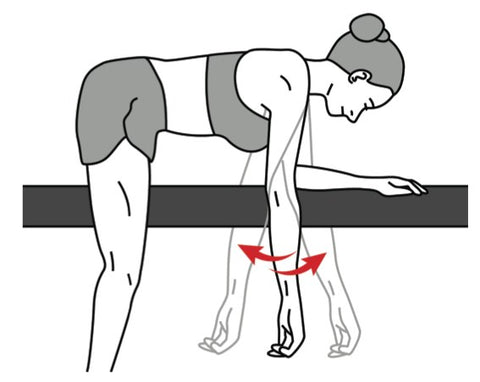Frozen Shoulder - The Importance of Movement

With a frozen shoulder it's always beneficial to get started as soon as possible with regular, gentle exercises.
The last thing you feel like doing if you have a frozen shoulder is moving it! However, the reality is that it is very important to keep the shoulder moving as much as possible.
Admittedly there are times when the shoulder is so acutely painful that all you can do is rest and put ice onto it. But it is beneficial to get started as soon as possible with regular, gentle exercises. These will help to:
• Aid the recovery and shorten the duration of your frozen shoulder. Prolonged immobility will only make the stiffness worse and allow inflammation to build up in and around the shoulder tissues, thus creating more pain.
• Significantly speed up your recovery. There is plenty of research evidence that shows that the cells which make fibrous bands in muscles (fibroblasts) respond well to mechanical activity. Exercise and stretching loosens the scar tissue that builds up in damaged muscles, and promotes increased healing.
• Have a positive effect on general well being. We often hear from patients about the general feeling of helplessness that is associated with a frozen shoulder, “there is nothing I can do”. Exercise helps to combat your lowered mood and allows you to “take charge” of the situation. Also exercise releases endorphins which have a well documented positive effect on mood.
• Improve muscle function and co-ordination. Right from day 1 of your frozen shoulder there is a loss of mutual muscle co-ordination and co-operation of the rotator cuff muscles. This occurs at the level of the brain. Exercising daily helps to reverse these effects.
• Stretch the sore and damaged muscle fibres in a controlled, co-ordinated and constructive way; lengthening the contracted and damaged areas within the muscles.
• Strengthen the weakened and (often) ‘wasted’ muscles.
• Speed up recovery - this is probably the most crucial thing from your perspective.

Are there any risks in exercising?
Really the risks of not exercising are much worse. As long as you avoid that sharp, catching type of pain that is associated with the early phases of your frozen shoulder there should be no risk of making the shoulder worse. Do follow these simple rules:
Always exercise to potential. It is important especially initially to start gently. Start with something that you know you can handle and step it up. Going into a major exercise routine too quickly will only make you sore!!
If it hurts stop!! Doing exercise that is painful is not beneficial – there are some people who have the attitude “no pain, no gain” this may be true in some cases but not in relation to rehabilitation exercises. Some slight aching in the shoulder during and after exercise can be expected but if it makes the pain worse you are doing too much.
Make sure you are doing the exercises correctly. If it doesn’t feel right then it probably isn’t, so try something else or look for further advice.
Read Latest Trigger Point Blogs
More articles about Frozen Shoulder
Find a Trigger Point Professional in your area
The information published on this website is not intended as a substitute for medical advice. The reader should regularly consult a physician or health care professional in matters relating to health and particularly in respect of any symptoms which may require diagnosis or medical attention. In the majority of cases of frozen shoulder syndrome there is no underlying illness or cause. However a proper diagnosis from a suitably qualified practitioner is advised. If you perform any exercises described on these pages, you do so at your own risk.
Disclaimer
The information in this article is intended for educational purposes within the context of continuing education for massage therapists, continuing education for athletic trainers, continuing education for physical therapists, continuing education for chiropractors, and continuing education for rehabilitation professionals. It is not a substitute for medical advice, diagnosis, or treatment. Although every effort has been made to ensure accuracy and reflect current understanding at the time of publication, practitioners must always work within the legal scope of their professional practice and follow all regional regulatory guidelines.
Hands-on techniques and clinical applications described in this material should only be performed by appropriately trained and licensed professionals. Individuals experiencing pain or symptoms should be referred to a qualified healthcare provider for assessment. Niel Asher Education is not responsible for any injury, loss, or damage resulting from the use or misuse of the information provided in this content.

Continuing Professional Education
Looking for Massage Therapy CEUs, PT and ATC continuing education, chiropractic CE, or advanced manual therapy training? Explore our evidence-based online courses designed for hands-on professionals.



















